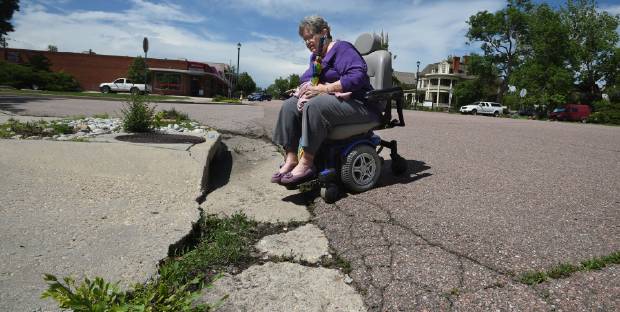The Gazette reported in 2015 that the city and El Paso County had fallen well short of the spirit and the letter of the ADA, leaving buildings and pathways inaccessible to the then-estimated 66,000 people with disabilities in the county. Many of those shortcomings fell into an unquantified backlog of noncompliance.
More than two years later, many of those shortcomings remain unquantified. And it seems the scope is expanding.
On Feb. 15, Stetson Hills residents Chris and Nikole Sweeney filed a lawsuit against the city and others alleging noncompliance with the ADA.
Since The Gazette’s 2015 report, Colorado Springs formed a working group to discuss building codes and procedures to address accessibility concerns in the area. The group met perhaps five times before it was disbanded, said city spokeswoman Jamie Fabos. Its work yielded two city ordinances, one tightening parking standards and a second declaring property owners – not the city – as the sole bearer of responsibility to ensure compliance with federal ADA standards in new buildings.
City planners alongside Patricia Yeager, CEO of The Independence Center, an advocate for people with disabilities in El Paso, Teller and other counties in the region, supported the second ordinance, saying it ensured prospective developers would be aware of the federal requirements. It’s especially important, they said, because the city doesn’t have the resources to ensure ADA compliance all over town, they said.
But City Councilmen Don Knight and Tom Strand voiced concerns.
“I don’t think we should just wash our hands of this and say it’s too big for us to do,” Strand said, noting the city must “have some kind of accountability.”
Former Councilman Larry Bagley suggested that the city might hire an ADA inspector, though that hasn’t happened.
The council passed the ordinance unanimously two weeks later.
The working group also produced a new section addressing ADA site accessibility on the city’s development plan checklist, Fabos said. However, a development plan’s approval doesn’t hinge on whether the standards are met.
Yeager said the city has improved access for the disabled in recent years, especially in commercial areas, but there’s still a long way to go, especially in residential areas. And the Sweeneys’ case highlights those shortcomings.
Just how much work needs to be done remains unclear.
When the ADA was enacted, governments were required to develop a transition plan meant to identify obstacles that might limit accessibility to the city’s programs, buildings or activities and outline the necessary steps to rectify those obstacles.
Michael Killebrew, the city’s first ADA coordinator, said such a plan was developed by the city sometime between 1991 and 1992 and was updated several times in 1995.
But since then the document hasn’t been touched.
And, Yeager added, “it wasn’t a quality plan at all.”
“When I was hired in 2014, I was tasked with performing a thorough self-evaluation and updating the city’s transition plan,” Killebrew said in an email in September. “I have been working on a rather extensive update to the plan that will encompass all city departments and enterprises.”
But it could still be more than a year before that is finished, he said.
Realistically, the city’s transition plan should have been updated multiple times in the last two decades, said Julian G.G. Wolfson, the Denver attorney representing the Sweeneys. An outdated or incomplete plan exposes Colorado Springs to lawsuits, compounds the city’s new and ongoing problems and quells input from those who might otherwise participate in the process.
“When a transition plan is being made or updated, the public entity is required to provide an opportunity to interested persons, which in this situation would include Chris and Nikole, an ability to participate in the development of such a plan,” Wolfson said. So far, the public has been left out of Killebrew’s work, Yeager said.
“The disabled community should be involved in setting those priorities. We’re the end users,” she said. “What might look good to the mayor or Jeff Greene (the city’s chief of staff), who don’t specifically have mobility impairments, might not fit for people with mobility impairments.”
Killebrew “has done a fabulous job with what he’s got, but they’re at a point where they need community involvement,” Yeager said.
And while it’s not required by the Department of Justice – the federal agency responsible for enforcing ADA compliance – the city should form its own committee to discuss additional accessibility concerns, Yeager said.
“It’s under best practices, underlined four times,” Yeager said, stressing the point.
But the reality is that the Sweeneys, and people like them, are now responsible for filing lawsuits to enforce the very laws meant to help them, Yeager said.
“We are all gnashing our teeth that that’s how it’s been for the last 27 years,” she said.
And for every family like the Sweeneys, there are more who have remained silent, sometimes trapped in their homes, Yeager said.
“People with disabilities have got to stand up, roll out and make their voices heard and continue on even if it means a lawsuit to get this change,” she said. “Nobody wants to live in a subdivision where they can’t even roll up or down the street or sidewalk.”
“They have to speak up and be heard,” she said. “And people who can’t get out as much as they would like can call the Independence Center, get a group together, they can get an attorney to help them file a lawsuit, they can call Mike Killebrew and tell him they need a curb cut.”
Source: gazette.com





Be the first to comment on "Lawsuit Raises Doubts About Colorado Springs’ Commitment to Comply With Access Laws"